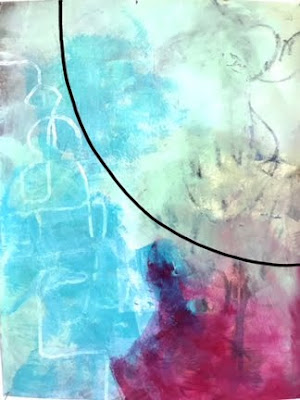Lesson 1 was about line and veiling. Lesson 2 was about rapidly laying down paint, then going back in with line and veiling. Lesson 3 is an exploration of shape, incorporating the tools of line and veiling that we've already covered.
I'm three weeks into the ten-week on-line course with Jane Davies and the pace is challenging. There are close to 50 active participants, all posting their 6 to 10 "explorations" weekly. So I get to see everyone's responses to the assignments, and to exchange observations with all of them, and I get to read the teacher's comments on their posts, as well as on mine.
This week, we are to make ten drawings exploring shape as a primary element.
- Line and pattern can be brought into play, but shape should be the focus.
- We are encouraged to use a variety of techniques to make our shapes,
- to make some compositions with minimal colour,
- to experiment with using just a few shapes, and
- to try using a large number of shapes.
I should also mention that we get instruction every week, in the form of videos. Many of these videos are available on Jane Davies' website, so have a look at the "videos and tutorials" link if you'd like to see what that's all about.
In this week's videos, we looked at using hand-cut stencils to create shapes. A variation on this is to fill in the stencil with stamping or scribbling, or to spritz alcohol on the shape in the stencil, allowing you to "lift" some paint on the selected area.
 |
We also looked at using "masks" to make shapes. Masks can preserve a background, allowing you to paint or splatter around it.
Shapes can be solid, or made with only an outline, whether that is created with paint, marker, charcoal, or watercolour crayon. Some media allow for smudged edges, others for clean or dry-brush edges. Shapes can be amorphous, like a cloud, or crisply defined. Then we have positive shapes (like the ring in the image below) or negative shapes (the hole in the middle of the ring.)
I tried to use a range of value, from dark to light, to combine shapes of varying size, and to use transparency and opacity. All these contrasts create interest in a composition.
I thought this last one was the most interesting. I liked the way the mosaic of rectangular shapes contrasted with the ambiguous black line underneath it. The line was made with watercolour crayon, and then I dripped water onto it with a pipette, allowing the water to dribble down, forming vertical lines that faded towards the lower edge of the paper.
So many things to try out!












































